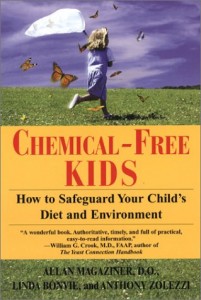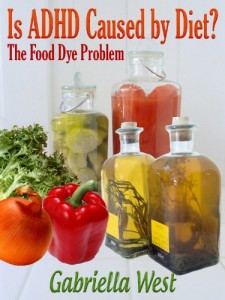ADHD-Linked Artificial Colors Fading Out Of Site
The good news about artificial colors, tenth on our list of food additives to be avoided, is that they’re now showing signs of fading from the food scene. That became evident just last month when the country’s two best known makers of chocolate candy announced they were phasing such synthetic dyes out of their products.

First Nestlé USA announced its commitment to removing FDA-certified colors, like Red 40 and Yellow 5, as well as artificial flavors, from all of its confections. By the end of 2015, more than 250 products and 10 brands including such standard candy bar brands as Butterfinger, Crunch, Chunky, Raisinets, Goobers, Oh Henry and Baby Ruth candy bars. The products will begin appearing on store shelves by mid-2015. “We’re excited to be the first major U.S. candy manufacturer to make this commitment,” noted division president Dorren Ida.
Not to be outdone, Hershey’s came out a few days later with its own “clean-label initiative” that not only included a pledge to “transition existing products” to exclude not only artificial colors and flavors, but high fructose corn syrup (our number one additive to be avoided) as well.
Such movies have not only come in response to consumer pressure, but from an acknowledgment by the Food and Drug Administration that at least 96 percent of children aged 2-5 years are being exposed to at least four artificial colors in food products – FD&C Red 40, Yellow 5, Yellow 6 and Blue 1. And that came six years after a petition was submitted to the FDA by the Center for Science in the Public Interest asking that nine such food colorings be banned — and that an interim warning label be posted on foods containing them that they “cause hyperactivity and behavioral problems in some children.” (The agency’s initial response to that and nearly 8,000 comments on the topic was to convene a Food Advisory Committee in 2011, which concluded there was not enough evidence to take regulatory action.)
But, as we reported here last September, research has increasingly demonstrated a connection between the consumption of synthetic food dyes and behavioral problems in kids. A few years ago, for example, studies were performed at Yale University’s Department of Pediatric Neurology to determine the effects of five common synthetic food dyes on baby rats. Only unlike experiments that have used excessive amounts of substances in question, these used the equivalent of the “real world” exposures our kids have to these dyes. And the results were alarming – the rats became hyperactive and showed diminished learning ability.

Nor is this an effect that has been confined to lab rats. A couple years ago, a British study, published in The Lancet, which found that artificial food dyes increased hyperactivity in children, prompted the American Academy of Pediatricians to acknowledge a link between their consumption and Attention Deficit Hyperactivity Disorder (ADHD) and to recommend parents try removing them from the diet of a child who suffers from the condition.
Or as we observed, the road to Ritalin could well be paved with all those FD&C’s you see listed among the ingredients of today’s processed food products. In fact, the link between food dyes (and certain other ingredients, as well as foods themselves) and behavioral problems in kids has been known for quite a while. It goes back to the 1970s when the late Dr. Benjamin Feingold, a California pediatrician and pioneer in the field of allergy and immunology, discovered the connection between what we eat and how it affects the way we feel and act. Since then, the Feingold Center he founded has helped scores of kids with hyperactivity and attention deficit disorder by eliminating certain additives from their diets – all without resorting to drugs such as Ritalin.
Of course, as in the case of other ingredients, European regulators have already beat us to the punch. Since 2010, they’ve required food products containing these unnatural hues to carry a warning label stating that consumption “may have an adverse effect on activity and attention in children.”
But wait – there’s more!
And hyperactivity isn’t the only health problem that might be caused by these fake hues. Red dye No. 40, a petroleum derivative and the most commonly used artificial color, has been known to cause allergic reactions such as hives and swelling around the mouth, and is a suspected carcinogen. Yellow No. 5 (tartrazine) has been linked to chromosomal damage and may cause allergic reactions and migraines. Yellow No. 6 (sunset yellow), currently banned in Norway and Sweden, can cause gastrointestinal distress, swelling of the skin, nettle rash and migraines, and may also be carcinogenic. And Blue No. 1, or “brilliant blue,” which has been banned in France and Finland, may trigger asthma, low blood pressure, hives and other allergic reactions. (It also caused serious complications and death in hospital patients when used in feeding tube solutions several years ago.)
But then, as we also previously noted, the entire history of artificial colors has been colored by controversy. While they may make products appear more attractive, they represent just the kind of chemical additives we should delete from our diets – something that’s especially true for kids. But then, the fact that so many supposedly “harmless” coloring agents have been found to be otherwise is hardly surprising when you consider their origins and backgrounds. Many of the older dyes were made from coal tar – a thick, black liquid derived from, well, coal. (Now, does that sound like anything you’d like to ingest?) Some are still in use today, while many newer ones are petroleum extracts. They may also contain measurable amounts of toxic contaminants, such as lead, mercury and arsenic.
Stay tuned for more updates on our top ten ingredients to be avoided (along with an extra one) in advance of our third annual Read Your Labels Day April 11.


